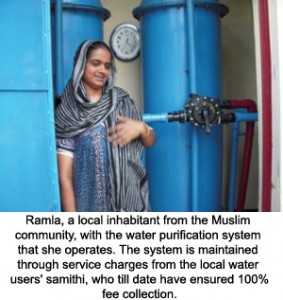The Mazhapolima program is quite unique; it aims to (eventually) recharge about 4.5 lakh dug wells in the district, and do this through community awareness and action. It's driven by the District Collector, Mr. Kurian Baby, who strongly advocates sustainable, local development & innovation.
A Gram Panchayat (GP) in Kerala is fairly large, and has a population of approximately 20000 people, as compared to about 10000 in Karnataka, and about 700 in Uttar Pradesh. GP's have ward divisions, about 20 of them per GP. Each GP has a staff of at least 6-8 people. The GP that we visited - Adat, had about 12 employees , 4 lower division clerks, 3 upper division clerks, 1 Joint Secretary, 1 Secretary, 2 peons and 1 sweeper. Except for the peons and the sweeper, the employees are all usually SSLC-pass, but here in Adat they were mostly graduates. For salaries alone, the GP spends about Rs 1.5 lakhs per month. Adat GP executed 124 projects last year. The GP's annual budget was Rs 1.40 crores, not including NREGA funds. Out of this, Rs 40 lakhs was raised by the GP through property taxes etc. Most other parts of the country, GP budgets are only about 5 to 10 lakhs. The Adat GP office was a large 2 storeyed building. Mr Vijayan, the Joint Secretary proudly showed us their awards, which filled up an entire wall. The result of the strong governance structure and investment made by the State Govt, was evident in the infrastructure. We visited a few areas to check out the water supply infrastructure. Kerala is mostly dependent on dug wells , bore wells are not too common because of the geology, which is sheet rock with few fractures. Almost all homes have dug wells, but some also have piped systems to supplement during the summer months.
This new program, Mazhapolima, is looking at rooftop rain water harvesting structures that recharge the dug wells after being filtered. The few homes that we saw had fairly robust RWH structures. The dug well water didn't look too clean though , but people usually boil the water before using it for drinking. In one habitation we visited, the head of that samithi took us to their water supply system. They had a fully-functioning water treatment system to deal with the iron, nitrate and bacteriological contamination. A middle-aged Muslim widow Ramla was responsible for managing the system in this habitation; she is paid Rs 1250 a month, and works for 3-4 hours a day - pumping, back-flushing etc. Local users shared the capital costs for the piped system, and monthly maintenance charges came to about Rs 30-50 per household. Collections are 100%, as water supply gets cut off, if you don't pay on time. Sanitation too is 100% they say. We didn't see any open defecation. Hardly saw any waste water, as the houses are all dispersed. The big issue now though, is water contamination. With heavy reliance on dug wells, and sanitation structures being mostly deep single pits, most water sources are getting contaminated. The program team now plan to understand their groundwater better, experiment with waste management approaches and focus a lot more on water quality. The Collector wants to use his position to bring in all the various departments to ensure integrated planning, and create a model that can be taken to the other districts. Arghyam Trust Bangalore, is in presently in discussion with the Government of Kerala, to provide support to the Mazhapolima program, for some additional components. The program presently has a fund commitment of about Rs. 4.5 crores from the State Government. Official District Website - Thrissur District
The program team now plan to understand their groundwater better, experiment with waste management approaches and focus a lot more on water quality. The Collector wants to use his position to bring in all the various departments to ensure integrated planning, and create a model that can be taken to the other districts. Arghyam Trust Bangalore, is in presently in discussion with the Government of Kerala, to provide support to the Mazhapolima program, for some additional components. The program presently has a fund commitment of about Rs. 4.5 crores from the State Government. Official District Website - Thrissur District
Location information:
View Larger Map















